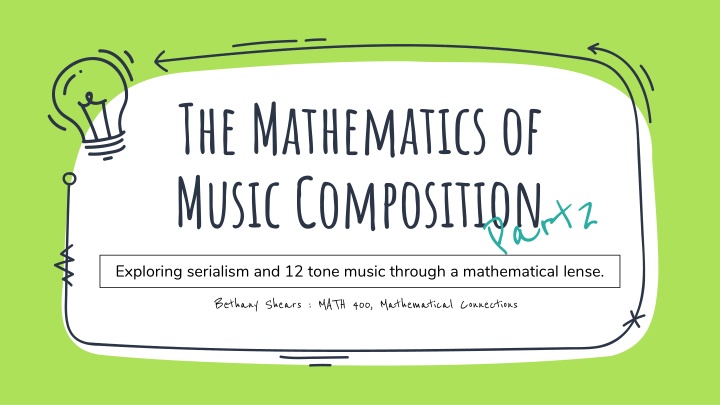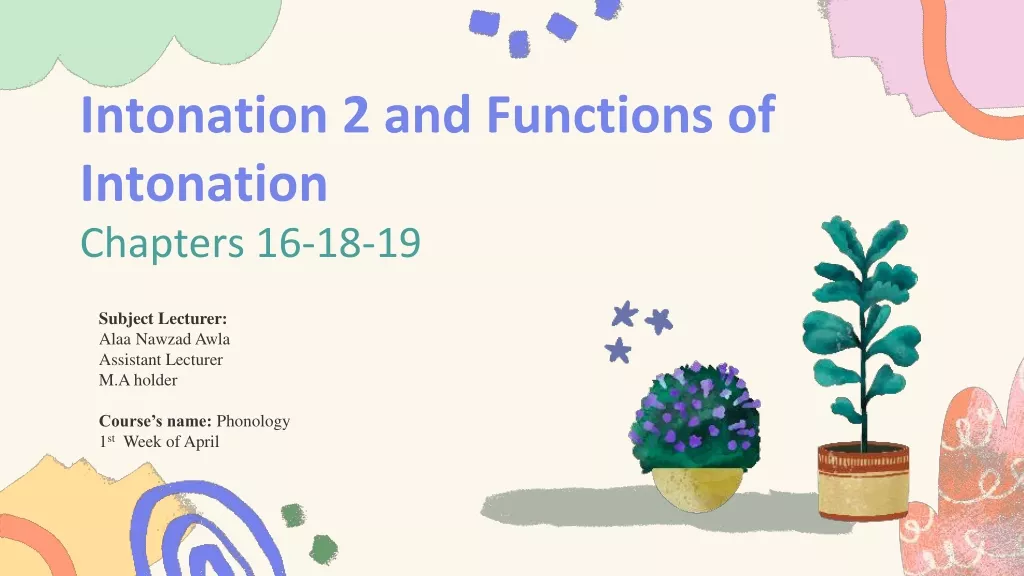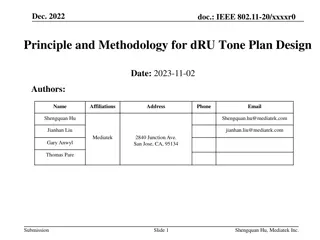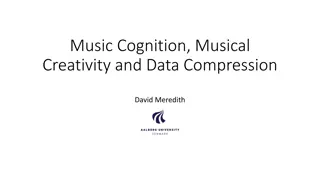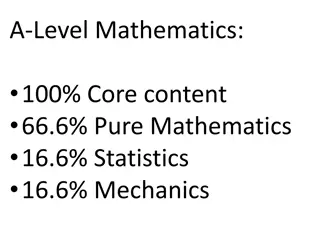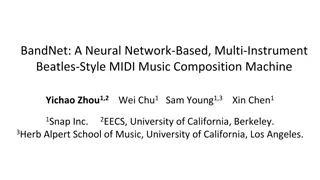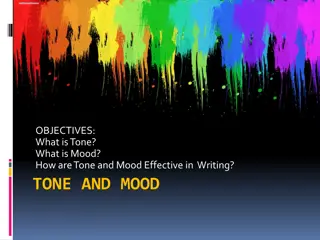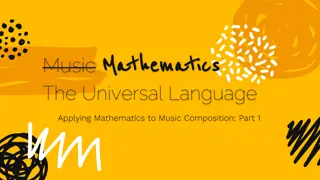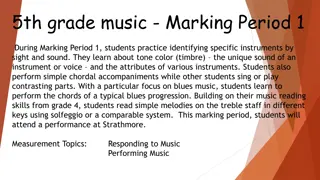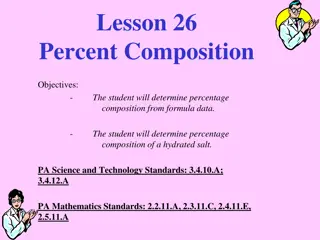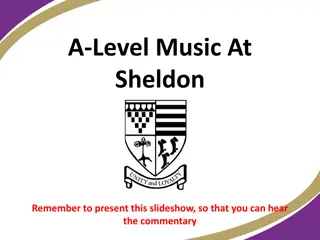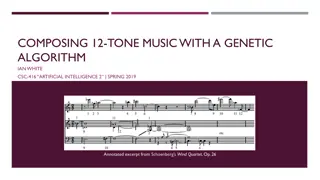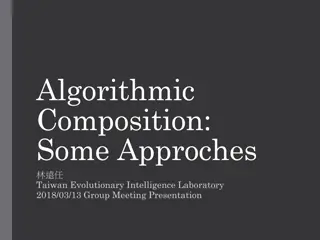The Mathematics of Music Composition: Serialism & 12-Tone Music
Delve into the mathematical approach to understanding serialism and 12-tone music in composition, exploring intervals, semitones, pitch mapping, and the influence of Arnold Schoenberg. Discover how these concepts reshape traditional Western music theory into experimental, chromatic compositions.
Download Presentation

Please find below an Image/Link to download the presentation.
The content on the website is provided AS IS for your information and personal use only. It may not be sold, licensed, or shared on other websites without obtaining consent from the author.If you encounter any issues during the download, it is possible that the publisher has removed the file from their server.
You are allowed to download the files provided on this website for personal or commercial use, subject to the condition that they are used lawfully. All files are the property of their respective owners.
The content on the website is provided AS IS for your information and personal use only. It may not be sold, licensed, or shared on other websites without obtaining consent from the author.
E N D
Presentation Transcript
The Mathematics of Music Composition Exploring serialism and 12 tone music through a mathematical lense. Bethany Shears : MATH 400, Mathematical Connections
Lets Recap A review of important concepts from Part 1.
Relevant Terms and Concepts Interval: The space between pitches. Semitone: The smallest possible interval (also called a half step ). 3
Relevant Terms and Concepts Interval: The space between pitches. Semitone: The smallest possible interval (also called a half step ). We are going to be thinking of pitches as mapped to numbers, considered modulo 12. C C#/D b D D#/Eb E F F#/Gb G G#/A b A A#/Bb B 0 1 2 3 4 5 6 7 8 9 10 11 4
Relevant Terms and Concepts Interval: The space between pitches. Semitone: The smallest possible interval (also called a half step ). We are going to be thinking of pitches as mapped to numbers, considered modulo 12. C C#/D b D D#/Eb E F F#/Gb G G#/A b A A#/Bb B 0 1 2 3 4 5 6 7 8 9 10 11 To find an interval above a given pitch, we add the number of semitones associated with the interval to the number associated with the pitch, and reduce modulo 12. For example: Major 7 above F# (or 10 semitones above the pitch 6): (6+10)(mod12) = 16(mod12) 4 (E) 5
Arnold Schoenberg Composer, Pioneer in Atonal Music Composition September 13, 1874 July 13, 1951 6
In the last presentation, we talked about traditional, Western music theory conventions. These are used to describe tonal music, or music that centers itself around certain pitches or keys. What is serialism and 12 tone music? 7
In the last presentation, we talked about traditional, Western music theory conventions. These are used to describe tonal music, or music that centers itself around certain pitches or keys. What is serialism and 12 tone music? Around the turn of the 20th century, there was a push towards more experimental and dissonant music composition, inspired by the increasingly chromatic pieces written by Romantic Era composers such as Franz Liszt. 8
In the last presentation, we talked about traditional, Western music theory conventions. These are used to describe tonal music, or music that centers itself around certain pitches or keys. What is serialism and 12 tone music? Around the turn of the 20th century, there was a push towards more experimental and dissonant music composition, inspired by the increasingly chromatic pieces written by Romantic Era composers such as Franz Liszt. As a response to this changing attitude towards music, Schoenberg devised a system for composing music completely atonally and with equal importance given to every pitch. This new style of music revolved around a specific ordering of the 12 different pitches, and manipulating that ordering in a specific series of ways (hence, serialism). 9
Establishing the Tools for 12-Tone Technique Creating a basis for the composition.
Creating and Manipulating the Tone Row 12 tone compositions begin with creating the Tone Row (or Note Row , in Europe). This is an ordering of all 12 pitches in any way that is desired. The more arbitrary the ordering, the more eclectic the music will sound. 11
Creating and Manipulating the Tone Row 12 tone compositions begin with creating the Tone Row (or Note Row , in Europe). This is an ordering of all 12 pitches in any way that is desired. The more arbitrary the ordering, the more eclectic the music will sound. Here is an example tone row: 0 9 7 3 4 5 2 11 10 8 1 6 We refer to this original ordering as Prime Form , and will consider it a 12-element array denoted by P. 12
Creating and Manipulating the Tone Row 12 tone compositions begin with creating the Tone Row (or Note Row , in Europe). This is an ordering of all 12 pitches in any way that is desired. The more arbitrary the ordering, the more eclectic the music will sound. Here is an example tone row: 0 9 7 3 4 5 2 11 10 8 1 6 We refer to this original ordering as Prime Form , and will consider it a 12-element array denoted by P. There are three basic operations we perform upon the Prime Form in order to create different patterns for our composition, namely: Retrograde, Inversion, and Retrograde Inversion 13
Creating and Manipulating the Tone Row Retrograde (R): Reverses the order of elements within the Prime Form array. P 0 9 7 3 4 5 2 11 10 8 1 6 R 6 1 8 10 11 2 5 4 3 7 9 0 14
Creating and Manipulating the Tone Row Retrograde (R): Reverses the order of elements within the Prime Form array. Inversion (I): Inverts each of the numbers in the Prime Form array, by the following method: P : Stays the same P : [ 12 - (P - P ) + P ] (mod12) P 0 9 7 3 4 5 2 11 10 8 1 6 I 0 3 5 9 8 7 10 1 2 4 11 6 15
Creating and Manipulating the Tone Row Retrograde (R): Reverses the order of elements within the Prime Form array. Inversion (I): Inverts each of the numbers in the Prime Form array, by the following method: P : Stays the same P : [ 12 - (P - P ) + P ] (mod12) Retrograde Inversion (RI): Reverses the order of the elements within the Inversion array. P 0 9 7 3 4 5 2 11 10 8 1 6 I 0 3 5 9 8 7 10 1 2 4 11 6 RI 6 11 4 2 1 10 7 8 9 5 3 0 16
Below is the Prime Form, Retrograde, Inversion, and Retrograde Inversion we just calculated. But what if we want our pattern transposed to a different pitch? What if we want this pattern starting on different notes? P: 0 9 7 3 4 5 2 11 10 8 1 6 R: 6 1 8 10 11 2 5 4 3 7 9 0 I: 0 3 5 9 8 7 10 1 2 4 11 6 RI: 6 11 4 2 1 10 7 8 9 5 3 0 17
We start with a 12x12 grid (called the 12-tone matrix ) and fill in the first row with our tone row. 0 9 7 3 4 5 2 11 10 8 1 6 What if we want this pattern starting on different notes? 18
Next, will fill in our Inverted array down the first column. 0 9 7 3 4 5 2 11 10 8 1 6 What if we want this pattern starting on different notes? 3 5 9 8 7 10 1 2 4 11 6 19
Finally, fill in the remaining rows with the formula: P : Stays the same, P : [ (P - P ) + P ] (mod12) 0 9 7 3 4 5 2 11 10 8 1 6 What if we want this pattern starting on different notes? 3 0 10 6 7 8 5 2 1 11 4 9 5 2 0 8 9 10 7 4 3 1 6 11 9 6 4 0 1 2 11 8 7 5 10 3 8 5 3 11 0 1 10 7 6 4 9 2 7 4 2 10 11 0 9 6 5 3 8 1 10 7 5 1 2 3 0 9 8 6 11 4 1 10 8 4 5 6 3 0 11 9 2 7 2 11 9 5 6 7 4 1 0 10 3 8 4 1 11 7 8 9 6 3 2 0 5 10 11 8 6 2 3 4 1 10 9 7 0 5 6 20 3 1 9 10 11 8 5 4 2 7 0
The 12-Tone Matrix Give Us the Following Useful Information 21
0 9 7 3 4 5 2 11 10 8 1 6 3 0 10 6 7 8 5 2 1 11 4 9 5 2 0 8 9 10 7 4 3 1 6 11 9 6 4 0 1 2 11 8 7 5 10 3 8 5 3 11 0 1 10 7 6 4 9 2 7 4 2 10 11 0 9 6 5 3 8 1 10 7 5 1 2 3 0 9 8 6 11 4 1 10 8 4 5 6 3 0 11 9 2 7 2 11 9 5 6 7 4 1 0 10 3 8 4 1 11 7 8 9 6 3 2 0 5 10 11 8 6 2 3 4 1 10 9 7 0 5 6 3 1 9 10 11 8 5 4 2 7 0 22
-------> Prime Form ----------------------------------> 0 9 7 3 4 5 2 11 10 8 1 6 3 0 10 6 7 8 5 2 1 11 4 9 5 2 0 8 9 10 7 4 3 1 6 11 9 6 4 0 1 2 11 8 7 5 10 3 8 5 3 11 0 1 10 7 6 4 9 2 7 4 2 10 11 0 9 6 5 3 8 1 10 7 5 1 2 3 0 9 8 6 11 4 1 10 8 4 5 6 3 0 11 9 2 7 2 11 9 5 6 7 4 1 0 10 3 8 4 1 11 7 8 9 6 3 2 0 5 10 11 8 6 2 3 4 1 10 9 7 0 5 6 3 1 9 10 11 8 5 4 2 7 0 23
-------> Prime Form ----------------------------------> -------> Inverse --------------------------------------> 0 9 7 3 4 5 2 11 10 8 1 6 3 0 10 6 7 8 5 2 1 11 4 9 5 2 0 8 9 10 7 4 3 1 6 11 9 6 4 0 1 2 11 8 7 5 10 3 8 5 3 11 0 1 10 7 6 4 9 2 7 4 2 10 11 0 9 6 5 3 8 1 10 7 5 1 2 3 0 9 8 6 11 4 1 10 8 4 5 6 3 0 11 9 2 7 2 11 9 5 6 7 4 1 0 10 3 8 4 1 11 7 8 9 6 3 2 0 5 10 11 8 6 2 3 4 1 10 9 7 0 5 6 3 1 9 10 11 8 5 4 2 7 0 24
-------> Prime Form ----------------------------------> -------> Inverse --------------------------------------> 0 9 7 3 4 5 2 11 10 8 1 6 3 0 10 6 7 8 5 2 1 11 4 9 5 2 0 8 9 10 7 4 3 1 6 11 9 6 4 0 1 2 11 8 7 5 10 3 8 5 3 11 0 1 10 7 6 4 9 2 7 4 2 10 11 0 9 6 5 3 8 1 10 7 5 1 2 3 0 9 8 6 11 4 1 10 8 4 5 6 3 0 11 9 2 7 2 11 9 5 6 7 4 1 0 10 3 8 4 1 11 7 8 9 6 3 2 0 5 10 11 8 6 2 3 4 1 10 9 7 0 5 6 3 1 9 10 11 8 5 4 2 7 0 25 <------- Retrograde <----------------------------------
-------> Prime Form ----------------------------------> -------> Inverse --------------------------------------> <------- Retrograde Inversion <------------------------ 0 9 7 3 4 5 2 11 10 8 1 6 3 0 10 6 7 8 5 2 1 11 4 9 5 2 0 8 9 10 7 4 3 1 6 11 9 6 4 0 1 2 11 8 7 5 10 3 8 5 3 11 0 1 10 7 6 4 9 2 7 4 2 10 11 0 9 6 5 3 8 1 10 7 5 1 2 3 0 9 8 6 11 4 1 10 8 4 5 6 3 0 11 9 2 7 2 11 9 5 6 7 4 1 0 10 3 8 4 1 11 7 8 9 6 3 2 0 5 10 11 8 6 2 3 4 1 10 9 7 0 5 6 3 1 9 10 11 8 5 4 2 7 0 26 <------- Retrograde <----------------------------------
-------> Prime Form ----------------------------------> -------> Inverse --------------------------------------> <------- Retrograde Inversion <------------------------ 0 9 7 3 4 5 2 11 10 8 1 6 Notice, also, that each number is used only once in each row and column, just as in sudoku. This makes it easy to check for errors in the matrix. 3 0 10 6 7 8 5 2 1 11 4 9 This is very useful, especially if you want to utilize the same pattern of intervals starting on a variety of different pitches. 5 2 0 8 9 10 7 4 3 1 6 11 9 6 4 0 1 2 11 8 7 5 10 3 8 5 3 11 0 1 10 7 6 4 9 2 7 4 2 10 11 0 9 6 5 3 8 1 10 7 5 1 2 3 0 9 8 6 11 4 1 10 8 4 5 6 3 0 11 9 2 7 2 11 9 5 6 7 4 1 0 10 3 8 4 1 11 7 8 9 6 3 2 0 5 10 11 8 6 2 3 4 1 10 9 7 0 5 6 3 1 9 10 11 8 5 4 2 7 0 27 <------- Retrograde <----------------------------------
Why Set these Parameters? The mathematical reasoning behind these operations.
The Bigger Picture Why do we use These Operations? The Cayley Table Schoenberg s phrase, The unity of musical space, while subject to many interpretations, suggests that he was well aware of the symmetries of the system ... he understood that there was a singular two-dimensional space in which his music lived Indeed, the basic transformations of the row, retrograde and inversion, plus retrograde-inversion for closure (and P as the identity) were ... shown to form a Klein four-group. -Robert Morris 29
The Bigger Picture Why do we use These Operations? Visual Representation of P, R, I, and RI P can transformed using reflection (left-right flip), inversion (up-down flip), or a combination of these (rotation through 180 ). These transformations are equivalent to the symmetries of a rectangle, embodied in the Klein 4-Group. Every element is its own inverse, and the product of (non-identity) elements is the remaining non- identity element. Remember, 12- tone music aims to give each pitch equal weight in composition. 30
Putting it all together! How these conventions become music.
1. Select any row (or column) in the 12-tone matrix you have created, in any format (Prime, Retrograde, Inversion, Retrograde Inversion). 1. Once you begin a row, you must follow it to completion. You must play all of the pitches in order, and you may not skip any pitches or repeat any pitches. The Rules 1. Notes may be played in any octave and for any duration. Pitches may also be play simultaneously, as long as they occur sequentially within the row. 1. Any number of rows (or columns) may be play concurrently, and can have varying lengths and formats. 32
Arnold Schoenberg -Piano Concerto, Op. 42 33
Works Referenced Arnold Schoenberg - Piano Concerto, Op. 42. YouTube, Olla-Vogala, 2 Dec. 2015, www.youtube.com/watch?v=JEY9lmCZbIc. Klein 4-Group. Art of Problem Solving, artofproblemsolving.com/wiki/index.php/Klein_4-group. The Klein 4-Group. ThatsMaths, 13 Feb. 2015, thatsmaths.com/2015/02/12/the-klein-4-group/. Lozano, Carolyn. How to Write a 12-Tone Composition. The Carolingian Realm, carolingianrealm.blog/HowToWriteA12ToneComposition.php. Morris, Robert. Mathematics and the Twelve-Tone System: Past, Present, and Future. Perspectives of New Music, vol. 45, no. 2, 2007, pp. 76 107. JSTOR, www.jstor.org/stable/25164658. Accessed 12 Nov. 2020. Twelve Tone Technique - Music Composition. YouTube, Music Matters, 11 July 2019, www.youtube.com/watch?v=wa_vhGPRuhs&t=627s. 34
